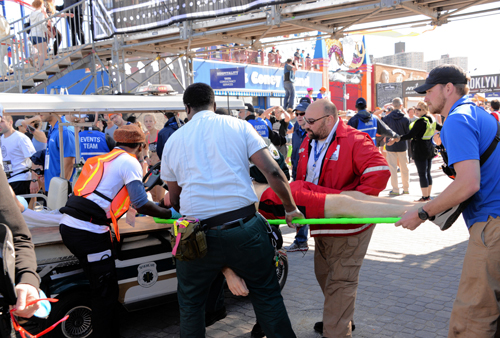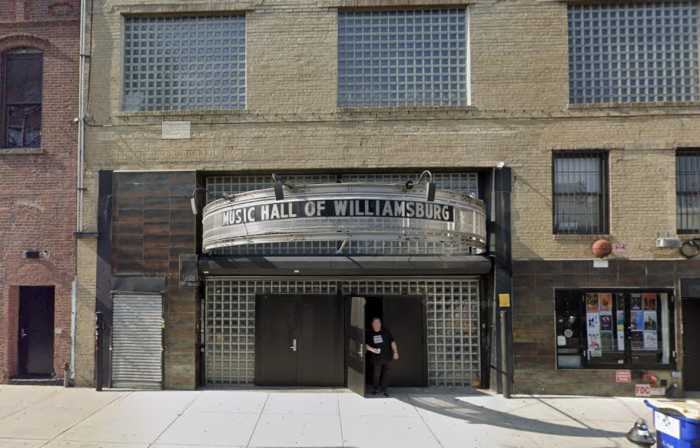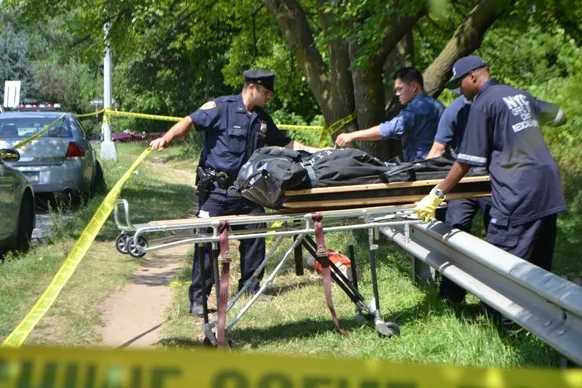The state is stonewalling our attempts to learn how a 31-year-old runner ended up dead after collapsing at the finish line of last month’s Brooklyn Half Marathon, refusing repeated requests for notes on how the runner was treated even though regulations require that such information be logged.
Instead, state officials demanded a Freedom of Information Law request for it to hand over the notes, a process that could delay the release of the information by months.
On the morning of May 17, John Mahaffey collapsed on the Coney Island Boardwalk at the finish line of the 13.1-mile road race. He later died of cardiac arrest, according to the Fire Department. Our photographer observed him convulsing on the ground, where he stayed for more than three minutes while race staffers stroked his arm and reassured him — but did not appear to provide medical treatment of any kind. He was then transported to an on-site medical station, according to race organizers, then Coney Island Hospital, where he perished, according to fire officials.
The race’s organizer, New York Road Runners, also won’t provide details on the credentials of the medical personnel at the scene, which treatments were administered, or when, citing family privacy.
The city, meanwhile, apparently doesn’t regulate medical staffing at large runs like the Half Marathon, which this year had 25,500 participants.
NYPD representatives said the department does not have staffing requirements for such events and that the mayor’s office “coordinates” them. The mayor’s office also passed responsibility, referring a reporter’s request to the state Department of Health.
The health department does require certain personnel levels and equipment for events with more than 5,000 attendees. It demands organizers keep on hand a long list of gear, but it omits defibrillators, devices that shock the heart to restore a normal heartbeat. The Road Runners claim they had some of the devices on hand, but refused to describe how many or who had them at the Half Marathon when a reporter asked in early June. Pressed further this week, a spokesman declined to say if the group’s staff is trained in using them, when a staffer would use one versus when city emergency personnel would, and if a staffer had ever administered the potentially lifesaving charge.
“Understand you are looking for more details, but I feel we’ve provided you with a fair amount of information through our previous answers,” New York Road Runners spokesman Chris Weiller wrote in an e-mail. “Doesn’t seem like you are asking about anything new.”
As far as staffing, for events with 15,001 to 30,000 attendees, the state requires “two emergency healthcare facilities on-site, each staffed by two emergency medical technicians; one ambulance on-site, staffed by at least one emergency medical technician; and the services of a physician available to the site within 15 minutes.”
At the Half Marathon, our photographer observed Mahaffey on the ground before 8:55 am, and photo time stamps show him being driven away on a golf cart at 8:58. Weiller said Mahaffey was moved to a medical station, but would not say who treated him or how, other than to stress that the care was “immediate and appropriate.” No one on hand contacted emergency dispatchers until 9:08 am, and an ambulance picked Mahaffey up at 9:09 am for transport to Coney Island Hospital, fire officials said.
The state is supposed to have a record of the day’s events on file along with documentation of Mahaffey’s treatment, per its own regulations, but a state spokeswoman refused to provide it, demanding we file a public records request. Such requests can take months or even years to yield fruit, if they ever do, because though the requested documents are meant to be readily available, the process governing the requests leaves room for agencies to withhold records on subjective bases, which can require lengthy appeals.
The city medical examiner’s office has not yet determined Mahaffey’s cause of death, but fire officials say his heart stopped.
Every minute delay in beginning CPR during cardiac arrest lowers a person’s chance of survival by 10 percent, according to Adam Singer, a professor in the Department of Emergency Medicine at Stony Brook University.
A study in the Journal of the American College of Cardiology states that most marathon deaths happen because of pre-existing heart conditions runners don’t know they have, and that one in 50,000 runners are at risk of sudden death while on the road.
Three runners died after the 2008 New York City Marathon, which had 37,899 runners and is also an annual New York Road Runners event, the New York Times reported. In 2010, the Times reported that the Road Runners’ approach to the full marathon’s healthcare had shifted from first-aid only to an elaborate system of medical stations and field hospitals.


























